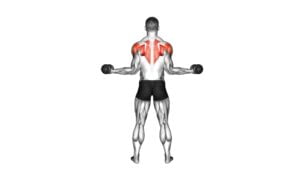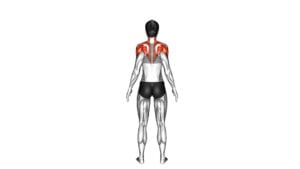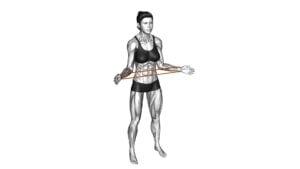Dumbbell Standing Scapular External Rotation (female) – Video Exercise Guide & Tips

Looking to strengthen your shoulder muscles? Check out this video exercise guide for dumbbell standing scapular external rotation.
Watch This Exercise Video
This movement targets your scapular muscles, improving stability and reducing the risk of injury.
Learn the proper form and technique, as well as the recommended dumbbell weight for female athletes.
Avoid common mistakes and maximize your results with these helpful tips.
Get ready to level up your shoulder workouts with this effective exercise.
Key Takeaways
- Dumbbell Standing Scapular External Rotation strengthens shoulder muscles and improves shoulder stability.
- Using the proper form and technique, such as keeping the elbows close to the sides and retracting the shoulder blades, is crucial for maximizing effectiveness and reducing the risk of injury.
- It is recommended to choose a dumbbell weight that allows for proper form and to gradually progress to avoid injury.
- Incorporating variations, modifications, different tempos, and rep ranges can help maximize results and prevent muscle adaptation and plateaus.
Benefits of Dumbbell Standing Scapular External Rotation
You will experience strengthened shoulder muscles through the dumbbell standing scapular external rotation exercise. This exercise is highly beneficial for improving shoulder stability and preventing shoulder injuries. By performing this exercise, you can target and strengthen the muscles responsible for stabilizing your shoulder joint, including the rotator cuff muscles and the muscles in your upper back.
The dumbbell standing scapular external rotation exercise specifically targets the muscles in your scapula, or shoulder blades. These muscles play a crucial role in providing stability to your shoulder joint, allowing for proper movement and reducing the risk of injury. By strengthening these muscles, you can improve your overall shoulder stability and reduce the likelihood of experiencing shoulder pain or discomfort during daily activities or sports.
Additionally, this exercise also helps to improve your posture by strengthening the muscles in your upper back. Good posture is essential for maintaining a healthy spine and reducing the risk of developing back or neck pain. By incorporating the dumbbell standing scapular external rotation exercise into your fitness routine, you can't only strengthen your shoulder muscles but also improve your overall posture and prevent future shoulder injuries.
Proper Form and Technique for Dumbbell Standing Scapular External Rotation
To perform the dumbbell standing scapular external rotation exercise with proper form and technique, focus on engaging your shoulder muscles and maintaining a stable posture throughout the movement. This exercise primarily targets the muscles of the rotator cuff, which are responsible for stabilizing the shoulder joint. By performing the exercise correctly, you can effectively strengthen these muscles and improve your shoulder stability.
To begin, stand with your feet shoulder-width apart and hold a dumbbell in each hand. Keep your elbows slightly bent and close to your sides. Engage your core and maintain a neutral spine throughout the exercise.
Start by retracting your shoulder blades, pulling them back and down. This will help activate the muscles in your upper back. From this position, externally rotate your shoulders, moving your forearms away from your body. Keep your elbows stationary and avoid any swinging or jerking movements.
Common errors to watch out for include using excessive weight, which can lead to improper form and potential injury. It's important to start with a weight that allows you to maintain proper technique. Additionally, avoid shrugging your shoulders or arching your back during the movement.
Variations of this exercise can include performing it seated or using a resistance band instead of dumbbells. Remember to always consult with a qualified fitness professional before attempting any new exercises, especially if you have any pre-existing shoulder issues.
Recommended Dumbbell Weight for Female Athletes
What is the recommended dumbbell weight for female athletes?
When it comes to choosing the right dumbbell weight for your workouts, it's important to find the right balance between challenging yourself and maintaining proper form.
Female athletes have a range of dumbbell weight options to consider, depending on their fitness level and goals.
For beginners or those new to strength training, it's generally recommended to start with lighter dumbbells, around 2-5 pounds, and gradually increase the weight as you build strength and confidence.
Intermediate athletes may find that using dumbbells in the range of 5-10 pounds provides an appropriate challenge for their workouts.
Advanced athletes, on the other hand, may opt for heavier dumbbells, ranging from 10-15 pounds or more, to continue pushing their limits and promoting further muscle growth.
Remember, the key is to choose a weight that allows you to perform the exercise with proper form and without compromising your safety. It's always better to start lighter and progress gradually than to risk injury by using weights that are too heavy for your current capabilities.
Now that you know the recommended dumbbell weight options for female athletes, let's move on to the next section and discuss some common mistakes to avoid during dumbbell standing scapular external rotation.
Common Mistakes to Avoid During Dumbbell Standing Scapular External Rotation
When performing the dumbbell standing scapular external rotation exercise, it's important to avoid common mistakes that can hinder your progress and potentially lead to injury. Here are some common mistakes to avoid and tips on how to improve your form:
- Using too much weight: Using weights that are too heavy can compromise your form and increase the risk of injury. Start with lighter weights and gradually increase the resistance as your strength improves.
- Shrugging your shoulders: Avoid shrugging your shoulders up towards your ears during the exercise. Keep your shoulders relaxed and pulled down away from your ears to engage the correct muscles and maintain proper form.
- Failing to maintain proper alignment: It's crucial to maintain proper alignment throughout the exercise. Avoid leaning forward or backward, and keep your spine straight and core engaged.
- Relying on momentum: Avoid using momentum to lift the weights. Instead, focus on using the targeted muscles to perform the movement slowly and controlled.
By avoiding these common mistakes and focusing on proper form, you can maximize the effectiveness of the dumbbell standing scapular external rotation exercise and reduce the risk of injury.
Now, let's move on to the next section where we'll discuss tips to maximize your results with this exercise.
Tips to Maximize Results With Dumbbell Standing Scapular External Rotation
To maximize your results with the dumbbell standing scapular external rotation exercise, focus on maintaining proper form and incorporating variations for added challenge. One of the common misconceptions about this exercise is that heavier weights always lead to better results. While using heavier weights can increase the intensity, it's important to prioritize proper form over the amount of weight lifted. This exercise targets the muscles of the shoulder and scapula, so it's crucial to engage these muscles throughout the movement.
In addition to maintaining proper form, incorporating variations and modifications can help maximize your results. One variation is to perform the exercise in a seated position. This can help isolate the muscles even more and provide a different angle of resistance. Another variation is to use resistance bands instead of dumbbells. This can add a different challenge and work the muscles in a slightly different way.
To further enhance your results, consider incorporating different tempos and rep ranges. Slow and controlled movements can increase time under tension and promote muscle growth. On the other hand, performing the exercise with quicker tempos can improve muscle endurance.
Frequently Asked Questions
How Often Should I Perform the Dumbbell Standing Scapular External Rotation Exercise?
To determine the frequency of the dumbbell standing scapular external rotation exercise, consider your fitness goals and current shoulder condition.
It's generally recommended to perform this exercise 2-3 times per week, allowing for adequate rest and recovery.
However, if you have any shoulder injuries, it's crucial to consult with a healthcare professional or a qualified trainer to modify the exercise according to your specific needs and limitations.
Safety and proper form should always be prioritized.
Can This Exercise Be Modified for Individuals With Shoulder Injuries or Limitations?
If you have shoulder injuries or limitations, modifications for shoulder rehabilitation can be made to the dumbbell standing scapular external rotation exercise. These modifications help ensure that you can still engage in shoulder strengthening while avoiding further injury.
By working with a qualified trainer or physical therapist, they can provide you with alternative exercises or variations of the dumbbell standing scapular external rotation that are suitable for your specific needs and limitations.
Always prioritize your safety and consult a professional for personalized guidance.
Is It Necessary to Warm up Before Performing the Dumbbell Standing Scapular External Rotation Exercise?
Before starting any exercise, it's important to warm up to prepare your muscles and joints for the activity ahead. Warming up has several benefits, such as increasing blood flow, improving flexibility, and reducing the risk of injury.
When it comes to the dumbbell standing scapular external rotation exercise, warming up is crucial to ensure proper shoulder stability and prevent strain or discomfort. So, make sure to include a warm-up routine before performing this exercise.
Are There Any Alternative Exercises That Target the Same Muscle Groups as the Dumbbell Standing Scapular External Rotation?
There are alternative exercises that target the same muscle groups as the dumbbell standing scapular external rotation. These exercises can help strengthen and stabilize the muscles around your shoulder blades.
Some options include seated dumbbell external rotations, standing cable external rotations, and resistance band external rotations. These exercises focus on the same muscle groups involved in the dumbbell standing scapular external rotation and can be a great addition to your workout routine.
Can This Exercise Be Incorporated Into a Full-Body Workout Routine, or Is It Primarily for Shoulder Strengthening?
To answer your question, the dumbbell standing scapular external rotation can definitely be incorporated into a full-body workout routine.
While it primarily targets shoulder strengthening, it also engages other muscles in your upper body, such as the back and arms.
By including this exercise in your routine, you'll not only strengthen your shoulders but also work on improving overall upper body strength and stability.
It's a great addition to a well-rounded workout plan.
Conclusion
In conclusion, the dumbbell standing scapular external rotation exercise is a beneficial way for female athletes to strengthen their shoulder muscles and improve their posture.
By maintaining proper form and technique, using the appropriate dumbbell weight, and avoiding common mistakes, athletes can maximize the results of this exercise.
Incorporating this exercise into a regular workout routine can help enhance shoulder stability and prevent injuries.

Author
Years ago, the spark of my life’s passion ignited in my mind the moment I stepped into the local gym for the first time. The inaugural bead of perspiration, the initial endeavor, the very first surge of endorphins, and a sense of pride that washed over me post-workout marked the beginning of my deep-seated interest in strength sports, fitness, and sports nutrition. This very curiosity blossomed rapidly into a profound fascination, propelling me to earn a Master’s degree in Physical Education from the Academy of Physical Education in Krakow, followed by a Sports Manager diploma from the Jagiellonian University. My journey of growth led me to gain more specialized qualifications, such as being a certified personal trainer with a focus on sports dietetics, a lifeguard, and an instructor for wellness and corrective gymnastics. Theoretical knowledge paired seamlessly with practical experience, reinforcing my belief that the transformation of individuals under my guidance was also a reflection of my personal growth. This belief holds true even today. Each day, I strive to push the boundaries and explore new realms. These realms gently elevate me to greater heights. The unique combination of passion for my field and the continuous quest for growth fuels my drive to break new ground.



